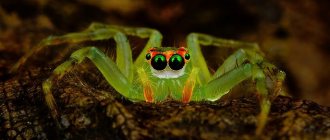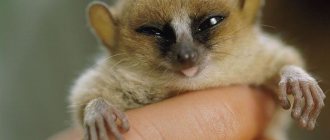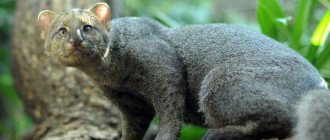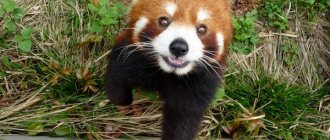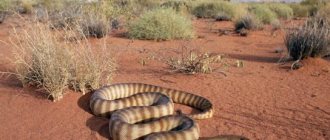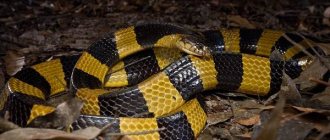From January 1, 2022, Russia has banned the ownership of animals whose natural habitat is very different from the conditions in captivity and which can be potentially dangerous to people. The list includes some reptiles and amphibians.
Is it possible to have snakes or spiders at home? More details
Which snakes are on the list of prohibited keeping at home?
The list of prohibited houses includes: king cobra (Ophiophagus hannah), collared cobra (Hemachatus haemachatus), all types of real cobras (Naja), all types of false Gunter cobras (Pseudonaja), all types of shield cobras (Aspidelaps), all types of arboreal cobras cobras (Pseudohaje), all species of desert cobras (Walterinnesia), all species of mambas (Dendroaspis), all species of taipans (Oxyuranus), sea snakes (Hydrophiinae), boomslang (aka "tree snake", Dispholidus typus), all species of vine snakes (Thelotornis), pythons (Pythonidae) and pseudopods (Boidae) over 4 m in length, chained viper (Daboia russelli), tiger rattlesnake (Crotalus tigris), sand ephas (Echis carinatus) and Gabon viper (Bitis gabonica).
Three of the most dangerous species
The most dangerous snakes in the world today are the black mamba, the taipan and the sand ephas. The powerful toxic components of the poison cause paralysis of the heart muscle, lungs and diaphragm, provoke suffocation of the victim, destroy muscle tissue and provoke severe bleeding. Mortality rates resulting from bites by these species are extremely high.
What kind of snakes can be kept in a terrarium at home?
If a person wants to get a snake, then it is better to choose a corn snake, experts advise. This snake is easy to care for and is ideal as a pet. The American snake and the royal python are also considered easy to care for and non-aggressive. According to herpetologist Vladislav Starkov , before purchasing an exotic animal, you must first study all the features of its maintenance: what to feed it correctly, where to place it, etc.
Question answer
Is it possible to keep a wolf at home? “Many people keep snakes because they know they rarely need to be fed. But it all depends on how well the owner takes care of the animal. Those who cannot care for a cat or dog are unlikely to be able to provide adequate care for a reptile. Everything primarily depends not on the animal, but on the person. There are, of course, reptiles that are difficult to keep at home. These are reptiles for which food is difficult to obtain. Some snakes, for example, feed on a special type of lizard. But no one keeps them, because there is no way to get the necessary food. And there are many snakes that reproduce well and live in captivity. At the same time, I would not recommend keeping very large reptiles. But everyone has their own taste and capabilities. Before making a choice, you should think about whether it’s worth getting a snake and then being responsible for it,” says Starkov.
The expert adds that a responsible approach is very important: “Now they have learned to breed reptiles. They have learned to keep them in captivity, but, like any animal, snakes need appropriate conditions. You cannot place an anaconda or a huge python in a small and poorly ventilated apartment. Such snakes really pose a danger; they can bite and cause large loss of blood or even strangle a small person. Therefore, everyone should first of all think about what the meaning of such content is.”
According to Starkov, it is definitely not worth keeping poisonous snakes at home. “As for other reptiles, if no one complains about them, they don’t run away to their neighbors, they can be safely kept at home,” he believes.
Main characteristics
The exotic pet snake is attractive because it is cold-blooded and calm. In nature, there are often species of reptiles that are not only completely unpretentious in keeping, but also quite easily tamed.
The entire body of a snake, regardless of the species, is covered with dry, scaly skin. Some have a special type of skin on the abdomen, which facilitates the process of moving the snake not only on loose soil, but also on a glass surface. Periodically, snakes change their epidermis (skin).
The eyes of all snakes are always covered with eyelids, which have the structure of special transparent scales. Because of these scales, it seems that the snake sleeps with its eyes open, but now we know that this is not so.
Quite often there are snake individuals whose body has a specific pattern, namely wide “ordinary” stripes. In addition to the pattern, the distinctive feature of snakes is that Mother Nature has endowed them with very developed organs that are very sensitive and respond well to heat. The thermal sensitivity organs of all snakes are located between the nose and eyes of the reptile. But the boa constrictor, python and viper, among other things, are also endowed with sensitive receptors that are located in the grooves of the head.
What should a terrarium be like?
The terrarium can be made of plastic or glass, the main thing is that it has ventilation and does not give the animal the opportunity to leave the designated area without permission. For reptiles, habitat zones with different temperatures (warm and cooler) are important, so it is desirable that there is a temperature gradient in the terrarium. For example, at the top you can make a platform with a lamp for the reptile to warm up, and at the bottom of the terrarium there is a cold zone. For tropical animals, a comfortable temperature will be 28-35 °C, for residents of subtropical latitudes - 24-30 °C.
Is it possible to keep a lynx at home? More details
The most dangerous pet snakes
Experienced connoisseurs of exotic animals are increasingly keeping poisonous snakes in their homes. Despite the fact that such species are necessarily kept in special terrariums, there remains a high risk of severe injury or a fatally poisonous bite, so it is very important to know all the behavioral characteristics of such snakes, and also be sure to take into account the degree of their toxicity.
Reticulated python
A massive reptile native to India or Vietnam, more than nine meters long. When kept at home, they require an artificial pond. They are able to move quite quickly through trees. The species is not poisonous, but the massive snake is capable of wrapping its large body around the victim and slowly squeezing it until death occurs.
Diamondback rattlesnake
The largest venomous snake in North America, up to two meters long. The species is prone to aggression, and its bite can be fatal. The potent poison causes severe pain, bleeding at the bite site and rapid swelling. Lack of timely and correct treatment can cause death.
King Cobra
The length of the reptile is often five meters or more. This is a poisonous snake - the longest in the world, distributed in India, Southern China and Southeast Asia. The king cobra feeds mainly on other species of snakes. Individuals that protect their offspring are more aggressive. Containing neurotoxins, the poison can quickly cause paralysis.
Common Jararaka
An adult snake grows up to a meter and is naturally distributed in southern Brazil, as well as northern Argentina and northeastern Paraguay. Leads a nocturnal lifestyle. The poison is dangerous and often fatal. The result of intoxication is tissue necrosis, as well as bleeding gums and profuse nosebleeds, which are accompanied by symptoms of renal failure and cerebral hemorrhages.
Daboya
The viper is native to the Indian subcontinent and neighboring countries, living in open areas and not in sparsely forested areas. Mainly nocturnal. Although somewhat slow, the snake can be aggressive, and as a result of the bite, blisters and swelling will form, vomiting, dizziness and severe external bleeding. Often the result of a bite is death.
Blue Bungarus
In natural conditions, the krait or bungarus prefers to settle near water bodies, in rice fields and dams. In search of food, the snake hunts at night. The bite is deadly, and the fatality rate reaches fifty percent even with timely use of antidote. Death, as a rule, occurs no later than a day after the bite.
What to feed snakes?
Human food is not suitable for adequate nutrition of reptiles. Depending on the species and preferences, snakes feed on rodents, birds; there are species that feed on snails and lizards. They can eat this food either fresh or frozen. You should not overfeed snakes; you need to take into account the fact that after swallowing food, the process of digesting it takes reptiles from 5 to 15 days. Therefore, young reptiles need to be fed once every 3 days, and adults - no more than once a week.
Kenyan cat snake
You can make a pet bed with your own hands. It is soft and very comfortable
When to collect birch sap in 2022 and how to choose the right tree
It’s easy to make a duvet cover of the desired size from two sheets: it turns out comfortable
Its size is about one and a half meters; these are unique creatures that love to make holes. They are generally docile snakes that bury their entire body under the sand and leave only their tiny head exposed. They are beautifully colored with yellow and brown patterns.
Amur snake
If you want a black snake, choose the Amur snake. In Europe and America it is called the Russian snake. This is the largest snake in the Far East, it grows up to 2 meters, like the imperial boa constrictor, but in captivity the size of an adult rarely exceeds one and a half meters.
The snake is found quite often in its habitat; it can bite out of fear, but it is not at all poisonous and does not pose any danger. The Amur snake is a diurnal snake and crawls around the terrarium quite actively; on the street it may even try to escape from you into the nearest thickets. It feeds on rodents, chicks and frogs.
It will not be easy for a beginner to distinguish individuals by sex, but there are still visual signs; males have a longer tail, and have a characteristic thickening at the base. Females have a shorter tail without thickening.
3rd place. Royal python.
They are often called "ball pythons" or "ball pythons" for their love of curling up into a ball. These are quite thick snakes with a wide variety of colors.
They lead a semi-diurnal lifestyle, the size of an adult snake reaches 1.5-2 meters, and life expectancy is up to twenty years. Unlike other pythons and boas, they lead a terrestrial lifestyle, not particularly interested in trees and snags. Rats, mice and gerbils are suitable for feeding (adults prefer them if they have not been accustomed to another).
Blue tongue skink
If the snake becomes a good first snake, then everyone who dreams of lizards should try to get skinks. This is a rather expensive pet, but when answering the question of which reptile is best to get, our consultants often suggest it.
A terrarium of 90*45*30 cm is suitable for keeping an adult animal.
In nature, skinks constantly dig in the ground, looking for food. Therefore, inside the terrarium there must be a suitable, safe substrate for this. You can use an inexpensive substrate made from a mixture of sphagnum and bark.
Like snakes, such lizards require the creation of cold and warm corners with temperatures of 25-26 and 35-40 degrees in the cold and warm zones, respectively. You need to monitor temperatures using a thermometer. This lizard is active during the day, so an ultraviolet lamp must be placed in the terrarium. You also need to organize constant access to drinking water - it is poured into a low drinking bowl and placed in a cold corner.
Skinks are omnivores. They eat insects and plant matter, so you don't have to deal with mice. They are also easy to tame and eat specialized Repashy food.
Standard feeding requirements:
Skinks need to be fed a variety of foods. When feeding, food is sprinkled with a special complex of vitamins and calcium.
Select content method
Decide where you will keep the snake, in a terrarium or container. This often depends on the age and size of the snake and how big it will grow. And also on the number of snakes you are going to get.
We prefer terrariums because snakes are easier to see, the terrarium fits better into the interior of the apartment and any design can be made in terrariums.
In the terrarium you can create any necessary living conditions for different animals:
We also use cages (containers)
Small, growing snakes are more comfortable in a container and are less stressed this way.
Calamaria linnaeus
Kalamaria appeared on the island of Java. It can also be seen in southern Asia, on the Sunda and Philippine Islands. Habitat: soil. Here she hides from prying eyes by digging tunnels. It hides in fallen leaves and under stones.
The snake is very fragile. The body reaches a length of just over 30 centimeters. The scales, head and tail have the same color. Thanks to this, the calamaria is saved from death. Insects and worms occupy the main place in the reptile's diet.
3. African egg-eating snake (Dasypeltis)
- Size: Men 12-18 inches and women 24-40 inches
- Availability: Relatively uncommon. Most likely, they will only be found in online advertisements and on breeder websites.
- Temperament: Very easy to handle. Has no front teeth!
- Feeding answer: Specialized feeder. Slow response to feeding.
Although these unusual snakes are not as readily available as others on this list, they are surprisingly easy to care for and are the only species that can be considered "vegetarian". African egg-eating snakes, as their name suggests, feed exclusively on eggs and do not require a whole animal to be preyed upon. The only catch is that you will need a reliable source of very small quail or finches that are preferentially fertilized. These eggs can be found in Asian food markets, online, and sometimes poultry farmers will provide them, however some are not fertilized. Reptilinks.com sells fertilized small eggs, although some have fully developed chicks that cannot be fed. If using frozen eggs, defrost in warm water and shake lightly until you notice a "splash" from the inside, then feed immediately. If you can find their food, these small snakes make excellent pets that lack front teeth but still rarely bite.
Sandy efa
This representative of small snakes is the most dangerous. The venom of the sand epha is toxic. The length of the reptile's body can be ninety centimeters. The color of the scales is usually light with shades of brown. There are small white stripes on the side.
The hunting period of the sand epha is night. At this time she is most active. Snakes choose dry habitats. You can see sand efu in thickets of bushes, on river banks, and in the mountains. It feeds on small rodents and frogs.
The poison of the sand epha is quite dangerous for humans. When bitten, the level of protein in the body that regulates blood clotting drops rapidly. This leads to open bleeding in the body.
Arizona adder
The Arizona adder is considered the smallest venomous snake. Habitat: deserts and forests with high humidity.
The reptile is found in the United States and northern Mexico.
In food it prefers small rodents and insects. It attacks the victim very quickly.
The scales of the Arizona adder are smooth. There are small shields. The head is rounded and has no cervical junction.
Children's python (Antaresia Children'si)
There are several other species of python that are closely related to the baby python and are very similar in appearance. The anthill python is the smallest python in the world, reaching only 24-30 inches in length. There are also the spotted python and the large-flowered python . These snakes have similar care requirements.
Kenyan Sand Boa
These tiny boas are fabulous for people who want a snake that stays small in both girth and length. They are colorful and can be placed in a tank as small as 10 gallons or a similar sized plastic tub. The cage does not even need a lot of decorations, since these snakes prefer to hide, and unnecessary objects may appear in their path. Just be sure to provide the recommended reasons. Most Kenyan sandbites have a reasonable disposition, although some people may be flighty, however they do not prefer to bite defensively. Bites can happen, however, if the snake mistakes your hand for food, but this can be avoided with proper handling.
